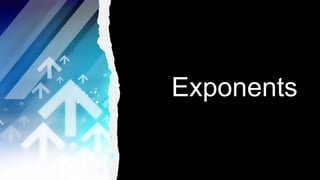
Math chapter 3 exponent and exponents as repeated multiplication
- 1. Exponents
- 2. 𝑎𝑐 An exponent is a symbol or a number at the upper right hand corner of a variable or a constant. It indicates the number of times the base is used as a factor. The base is the repeated factor in a product. ‹— exponent ‹— base
- 3. An exponent tells how many times a number, called the base, is used as a factor. Thus, 3 • 3 • 3 • 3 • 3 can be written as 35 7 • 7 • 7 • 7 • 7 • 7 • 7 can be written as 77 a • a • a • a • a • a can be written as 𝑎6 xy • xy • xy • xy can be written as (𝑥𝑦)4 or 𝑥4𝑦4 In the given exponential notations above; 3, 7, a, and xy are bases; and 5, 7, 6, , and 4 are the exponents.
- 5. This is the Bar of 5, and this is the Square of 5. Five to the second power or 5 ‘squared’. We write as 52 This term was first applied to the power of 2 by al- Khwarizmi, the Father of Algebra in the 9th century. Euclid, a Greek mathematician who lived over 2000 years ago, was the first to use the word power. He thought of the secondary power as being the square of a line.
- 6. The cube of 5 We write this as 53, but instead of calling this the ‘third power,’ he also called it ‘5 cubed.’ The words in Arabic were ‘mai’ for ‘square, and ‘kab’ for ‘cube.’ About 600 years later, other Arab mathematicians shortened this to just the first letter. So if they wanted to write 53, they would write 5k and 52 would be 5m.
- 7. The idea of a special notation for repeated multiplication was very limited until the 15th century when Nicolas Chuquet used a form of exponents. He didn’t invent the words million and billion, but he was the first to use the ending ‘illion’ to represent powers of 10. Robert Recorde invented words for higher powers above the cube about a hundred years later, but he is more famous for inventing the equal sign.
- 8. For example, if we wanted to write one million, we could simply write 1,000,000, which is pretty quick. But how else could we write this? We could write 106. 10100 A number with 100 zeros. How long would it take to write this whole number out?
- 9. Robert Recorde gave names to powers up to 8, but never up to 100! The only reason this number is interestingly is because it has exactly 100 zeros. As recently as 1938, American mathematician Edward Kasher popularized the name ‘googol’ for the number, although actually it was his 9 year-old nephew who called it that; and that name has stuck ever since. So 10100 is a googol. Now let’s try and write 10googol. This means a one followed by a googol of zeros, and it is called a googolplex.
- 10. Exponent is a simple way to write a repeated multiplication. 7.7. 7.7. 7.7. 7.7. 7.7 can be written very concisely as 710 The number that is being repeated is called the base, and the number at the top tells us how many instances of the base have been multiplied together. That number is called exponent.
- 11. It comes from the Latin exponere meaning to put forth. We can write numbers in exponential form, like 710, or in expanded form, like 7.7. 7.7. 7.7. 7.7. 7.7.
- 12. Example: Evaluate 23, 34, and 45 Solution: 23 = 2 . 2 . 2 = 8 34 = 3 . 3 . 3 . 3 = 81 45 = 4 . 4 . 4 . 4 . 4 = 1,024
- 13. How would we evaluate -24 ? Solution: -24 = - 2 . 2 . 2 . 2 = -16
- 14. How would we write -2 . -2 . -2 . -2? Solution: We enclose the “-2” inside the parentheses and raise it to the power of 4. -2 . -2 . -2 . -2 = −2 4 = 16
Editor's Notes
- Even after exponents were invented not everyone used them in the same way or consistently. So they are relatively new when we think of how long humans have been counting. But they are such a wonderful invention. Just as the decimal system and Arabic numbers help people do arithmetic so much more efficiently, exponents, which came much, much later, enabled people to represent quantities and do even more complex calculations so much faster and efficiently than ever before.
- Now this number we could multiply out, but we usually do not if the numbers are very large. When we get an actual number for this, we say that we have ‘evaluated’ this number.”
- We need to be very careful. The exponent applies only to the symbol directly behind it. What is right next to the exponent of 4? It is a 2. So we will only repeat the 2 four times. The negative (or minus) sign stays there and is not affected.
- Once again, the exponent only applies to the symbol directly it. What is that symbol here? It is a parenthesis. So the whole set of parentheses, and everything inside gets multiplied together four times.